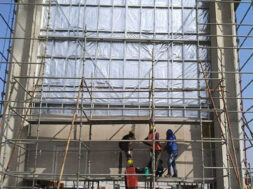Polybond: Making buildings energy efficient
To reduce the energy intensity of buildings use of efficient insulation materials is necessary and this is where Polybond Insulation plays a key role
M/s. Polybond Insulation Pvt. Ltd., established in 1995 is one of the leading manufacturers, suppliers and exporters of mineral wool products in India. The company specializes in the
manufacturing of all kinds of thermal insulation, acoustic insulation & fire-retardant products. In India the company has three manufacturing units in the state of Chhattisgarh, India.
‘Polybond’ is an ISO 9001:2015, OHSAS 45001:2015 certified company and its workflow is defined as per ISO guidelines. About 33% of electricity consumed in India every year is
accounted for by the residential and commercial building sectors. Going by the projection that the country would add 700–800 million square meters annually to its building stock for the next 20 years, one can very well imagine the high quantum of energy consumption anticipated from these sectors over the coming years. While this expected development scenario is welcome for India’s progress, the worrisome factor is the increasing energy intensity of buildings that are being constructed today. In a business-as-usual scenario, the building sector is bound to eat up a large share of India’s precious energy resources.
It is therefore important to control and bring down the energy intensity of buildings that are yet to come. The external surfaces of buildings (roof and walls), which are exposed to direct sunlight, transmit the heat absorbed by them to the inner areas of a building, causing thermal discomfort to its occupants. In colder regions, more energy is required to keep the buildings warm enough for its occupants. By using efficient insulation materials, considerable energy can be saved. In India, not much attention has been given to the thermal insulation of buildings from the perspective of energy efficiency. This may perhaps be due to lack of awareness among architects and builders or due to lack of R&D on insulation in our country.
In a hot country like India, the external surfaces of the building envelope, for example, the roof and walls, which are particularly exposed to direct solar radiation, get heated up at temperatures higher than the prevailing temperature inside the building. From the building envelope, the heat gets transferred through thermal conduction to the inner surfaces of the roof and walls, creating an unwanted heat source within the occupants’ space. The heat gets distributed inside the building further, through radiation and convection, causing much discomfort to the occupants. Hence, it becomes essential that the occupants’ space has the means to ensure good air circulation, ventilation, space cooling, and so on, usually achieved by energy-driven electrical fans and air-conditioning systems.
Insulating materials, due to their low thermal conductivity, can substantially resist transfer of heat from the exterior to the interiors of the building if external temperature is high, and resist heat transfer from interiors to the exterior in a similar way when the external temperature is low.
R-value of Insulation Materials
Higher the R-value, greater is the insulating effectiveness of the material. The R-value depends on the material’s characteristics, its thickness, and thermal conductivity. The density of the material also affects its thermal conductivity. The lower the thermal conductivity of the material and larger its thickness higher is its R-value.
How Thermal Insulation Functions
The individual fibres of the batt work to partition off air into small pockets, isolating and trapping it. This stops convective heat from rising through it, by preventing the heat from transferring from one air pocket to the next.
Insulation Application in Roof and Walls
Normally, buildings are conventionally built with brick walls and reinforced cement concrete (RCC) slabs as ceilings. They have relatively high thermal conductivity. Therefore, such
materials offer lesser thermal resistance as compared to that provided by several insulation materials and products, unless their thicknesses are increased substantially to attain
desired thermal comfort. Insulation products can be applied on the external or internal surfaces of the components of the building envelope, namely the roof and walls, or within the
space between two thin walls, as shown in Figures 3, and 4.
What Building Designers Should Look for
Thermal insulation materials/products can play an important role in enhancing the thermal comfort in non-air conditioned buildings and in reducing the need for energy-intensive cooling or heating requirements in air conditioned buildings. The importance of thermal insulation materials is now being realized by building designers and developers who are conscious about thermal comfort and energy performance of buildings.
For more informatiom,
visit: www.polybond.co.in
40
Cookie Consent
We use cookies to personalize your experience. By continuing to visit this website you agree to our Terms & Conditions, Privacy Policy and Cookie Policy.






